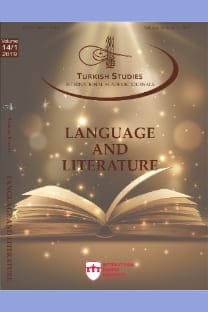Sufi Calligrapher in Visoko, Bosnia-Herzegovina: Huseyin Zilko Efendi and His Cönk
Sufi Calligrapher in Visoko, Bosnia-Herzegovina: Huseyin Zilko Efendi and His Cönk
___
- Algar, H. (2007). Nakşibendilik. İnsan Yayınları.
- Algar. H. (2020). Abdurrahman Sırrî Baba. TDV İslâm Ansiklopedisi (DİA). TDV Yayınları, (Ek-1), 19-20.
- Altuntaş, İ.H. (2014). Gavs-ül Âzam İhramcızâde Hacı İsmail Hakkı Toprak Nakşî-Hâkî Tarikâtı ve İlm-i Ledün Sırları. Gözde Matbaacılık.
- Aksoy, Ö. (2018). Türk kültürü etkisinde teşekkül eden edebî gelenek: Boşnak Alhamiyado geleneği. Türük Uluslararası Dil, Edebiyat ve Halkbilimi Araştırmaları Dergisi, 6 (14), 184-197.
- Aksoyak, İ.H. (2016). Cönk imlâsı. Milli Folklor, 28 (111), 5-13.
- Artun, E. (2008). Dini-tasavvufî halk edebiyatı. Kitabevi Yayınları.
- Ćehajić, D. (1986). Derviški redovi u jugoslovenskim zemljama sa posebnim osvrtom na bosnu i hercegovinu. Orijentalni Instıtut u Sarajevu Yayınları.
- Ćehajić, D. (1999). Nakşibendî tarikatının Bosna-Hersek ve genel olarak Yugoslavya’daki sosyopolitik durumları. Dinî Araştırmalar, 2 (5),377-386.
- Duymaz, A. (2016). Sözün yazılaşması yazının sözleşmesi: cönkler. Millî Folklor,28 (111), 14-27.
- Erdoğan, K. (2004). Bosnalı Hasan Kâimî ve Divanı’nın Manisa nüshası. Hacı Bektaş Veli Dergisi, (31),257-269.
- Gökyay, O.Ş. (1993). Cönk. TDV İslâm Ansiklopedisi (DİA). TDV Yayınları, (8), 73-75.
- Güzel, A. (2014). Dinî-tasavvufî Türk edebiyatı el kitabı. Akçağ Yayınları.
- Handžıc, D. & Kadrić, A. (2004). Kitab Mustafa mujič. Libris Yayınları.
- İzeti, M. (2013). Balkanlar’da tasavvuf. İnsan Yayınları.
- Kara, M. (2001). Balkanlar’da Türk tasavvuf edebiyatına genel bakış. Uludağ Üniversitesi İlâhiyat Fakültesi, 10(2),1-26.
- Köprülü, O. F. & Uzun, M. (1989). Akşemseddin. TDV İslâm Ansiklopedisi (DİA). TDV Yayınları, (2), 299-302.
- Kreševljaković, H. (1934). Visoko. Novi Behar, 8(11-12), 31-55.
- Ljubović, A. & Aruçi, M. (2000). Abdülvehhâb İlhâmî. TDV İslâm Ansiklopedisi (DİA). TDV Yayınları, (22), 101-102.
- Numanagic, A. (2012). Hadži Hafiz Hûsni Efendija numanagić, šejh i muftija na razmeđu vremena. Dobri Bošnjani Yayınları.
- Samic, J. (2001) Hasan Kāimî. TDV İslâm Ansiklopedisi (DİA). TDV Yayınları, (24), 215.
- Selçuk, E. (2014). Balkanlar’a uzanan bir köprü: nakşi divan şairleri. Osmanlı Mirası Araştırmaları Dergisi, 1(1), 1-15.
- Sikirić, Š. (1918). Derviskolostorok és szent sirok Boszniában. Turan 2(9), 598-607.
- Tatcı, M. (2011). Burc-ı belâda bir merd-i hudâ Niyâzî-i Mısrî. H Yayınları.
- Tatcı, M. (2019). Yûnus Emre’nin Gönül Çocuğu Bursalı Âşık Yûnus. H Yayınları.
- Tatcı, M. (2021). Yûnus Emre Dîvân-ı İlâhiyât-Risâletü’n- Nushiyye-Âşık Yûnus, C (2). H Yayınları.
- Ülkütaşır, Ş. (1967). Halk edebiyatı araştırmalarında cönk’lerin değeri, Türk Kültürü, 5(60), 905- 907.
- Vukic, T. P. (2012). Mecmûa incelemelerinin sınırları ve olanakları: Bosna mecmûalarına bir yaklaşım, Eski Türk Edebiyatı Çalışmaları VII, 53-71.
- http://www.znaci.com/tekstovi/sejh-hadzi-hafiz-mustafa-efendija-mujic-sejh-hafiz-s-paleza-portretjednog- savremenog-duh Boşnakçadan Türkçeye Çeviri 01.02.2014-22:59
- www.notaarsivleri.com%2FNotaMuzik%2Fsoydum_kabayi_askin_elinden.pdf&clen=284785&chu nk=true 15.12.2021-17:49
- ISSN: 2667-5641
- Yayın Aralığı: 4
- Başlangıç: 2006
- Yayıncı: ASOS Eğitim Bilişim Danışmanlık Otomasyon Yayıncılık Reklam Sanayi ve Ticaret LTD ŞTİ
Carl Czerny Op.777 “Five Finger Studies” Piyano Kitabının Teknik Analizi
Nazariyatçı Bestekârlara Göre Türk Müziğinin Biçimsel Analizi
Amel’in Bir Mûsikî Unsuru Olarak Divan Şiirinde Kullanımı
Klasik Türk Edebiyatının Eğlenceli Tipleri I: Kâsebâz
Elazığ Halk Kültüründe Ölüm Gelenekleri
Kırgız Türkçesinde Duygu Fiillerinin Semantik Yapısı ve Etimolojisi Üzerine Bir İnceleme
Muhammed Ali İsmail FAKİRULLAHOĞLU
Mavi Anadoluculuk’ta Batı Medeniyeti, Anadolu Kimliği, Halk ve Hümanizma Anlayışı
